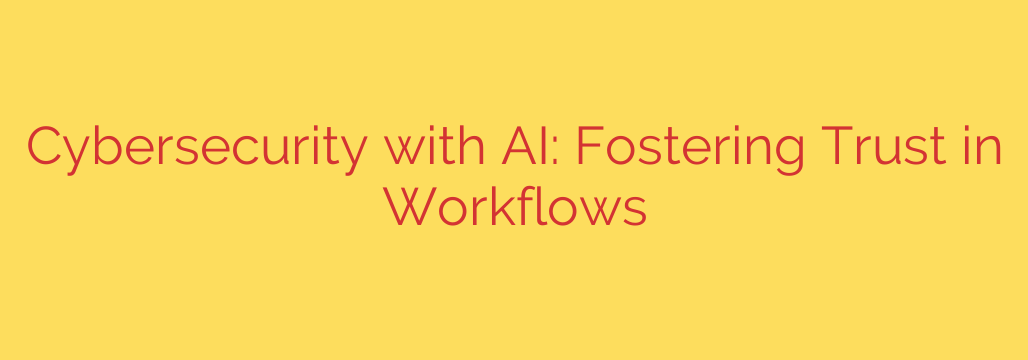
AI in Cybersecurity: How to Build Trust and Enhance Your Defenses
The digital landscape is more complex and dangerous than ever. Security teams face a relentless barrage of alerts, sophisticated attack vectors, and an overwhelming amount of data. In this high-stakes environment, Artificial Intelligence (AI) has emerged not as a luxury, but as a critical necessity for mounting an effective defense. AI can analyze threats at a scale and speed that is simply impossible for human analysts alone.
However, integrating AI into security workflows introduces a significant challenge: trust. How can we rely on a system to make critical security decisions when its internal logic is often a “black box”? For AI to be truly effective, security professionals must trust its outputs. This trust isn’t granted automatically; it must be carefully cultivated through transparency, validation, and a clear understanding of AI’s role as a partner, not a replacement, for human expertise.
The Power and Peril of AI in Security
AI offers transformative capabilities for cybersecurity operations. It excels at identifying subtle patterns and anomalies across vast datasets that would otherwise go unnoticed.
The key benefits include:
- Proactive Threat Hunting: AI algorithms can predict and identify potential threats before they fully materialize by analyzing network traffic and user behavior for deviations from the norm.
- Automated Incident Response: Upon detecting a threat, AI can instantly execute predefined security protocols, such as isolating an infected endpoint or blocking a malicious IP address, dramatically reducing response times.
- Enhanced Malware Detection: By moving beyond simple signature-based detection, AI can identify novel and polymorphic malware strains based on their behavior and characteristics.
Despite these advantages, hesitation remains. The primary source of this distrust is the “black box” problem. When an AI model flags an activity as malicious, analysts need to know why. Without a clear, logical explanation, it’s difficult to validate the alert, rule out a false positive, or justify a response to leadership. Trust erodes when a tool provides answers without explanations.
Building the Foundation: Four Pillars of Trust in AI Security
Fostering trust in AI-powered security is an active process. It requires a strategic approach focused on transparency, reliability, and collaboration. Organizations can build a strong foundation by focusing on four key pillars.
1. Prioritize Explainable AI (XAI)
Explainable AI is the direct antidote to the black box problem. XAI frameworks are designed to make AI decision-making processes transparent and understandable to human operators. When an AI system generates an alert, an XAI model will also provide the specific data points, rules, and risk factors that led to its conclusion. This allows analysts to quickly verify the finding and build confidence in the system’s reliability. When selecting AI security tools, prioritize vendors that offer clear, interpretable outputs.
2. Ensure High-Quality Data and Rigorous Model Training
An AI model is only as good as the data it’s trained on. Biased, incomplete, or inaccurate training data will inevitably lead to a flawed security tool that produces unreliable results and frequent false positives. To build trust, you must first trust your data. This involves a commitment to clean, well-labeled, and relevant data sources for training and continuous validation of the model’s performance against real-world scenarios.
3. Implement a Human-in-the-Loop (HITL) Approach
The most effective security posture combines the strengths of both machine and human intelligence. An HITL approach positions AI as a powerful assistant to the security analyst, not a replacement. In this model, the AI handles the heavy lifting of data analysis and initial threat detection, flagging suspicious events for human review. The analyst then applies their experience, intuition, and contextual understanding to make the final judgment. This partnership ensures that critical decisions are validated by human experts, preventing over-reliance on automation and reducing the risk of error.
4. Establish Clear Performance Metrics and Continuous Monitoring
Trust requires verification. It’s essential to establish clear Key Performance Indicators (KPIs) to measure the AI’s effectiveness. Track metrics such as the reduction in false positives, the speed of threat detection, and the accuracy of its classifications. Furthermore, AI models can “drift” over time as the threat landscape evolves. Continuous monitoring and periodic retraining are crucial to ensure the AI remains accurate, relevant, and aligned with your organization’s security goals.
Actionable Tips for Secure AI Integration
- Start with a Focused Pilot Program: Begin by deploying an AI tool in a specific, low-risk area of your security operations. Use this pilot to evaluate its performance, fine-tune its configuration, and allow your team to become comfortable with its capabilities.
- Invest in Team Training: Your security analysts need to understand how the AI works, its limitations, and how to interpret its outputs. Training builds the skills necessary for an effective human-machine partnership.
- Develop Incident Response Plans for AI Failures: No system is perfect. Plan for scenarios where the AI might fail, produce a critical false negative, or be targeted by attackers. A clear response plan ensures you are prepared for any contingency.
- Demand Transparency from Vendors: When evaluating AI security solutions, ask tough questions about how their models are trained, how they ensure data privacy, and the extent to which their decision-making process is explainable.
Ultimately, integrating AI into cybersecurity is a journey toward a more intelligent and resilient defense. By focusing on building a foundation of trust through transparency, human oversight, and continuous validation, organizations can unlock the full potential of AI to not only manage the threats of today but also anticipate the challenges of tomorrow.
Source: https://securityaffairs.com/181278/security/ai-for-cybersecurity-building-trust-in-your-workflows.html








